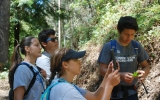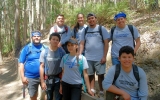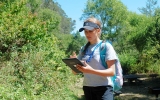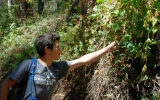What did you do this summer?
These local students use GPS technology to map park features and trails, pinpoint invasive plants in quest to improve County Parks.

Local high school students spend the summer restoring trails, mapping parks and pinpointing invasive plants for removal later.

Bottom row, left to right: Guillermo Vazquez, Carlos Maciel, Maria Contreras and Eduardo Diaz. Top row, left to right: Ivan Nava, Artemis Mosier, Juan Valle and Aurora Lopez.
As the summer sun burned off the morning fog, a team of students led this day by 16-year-old Maria Contreras left the visitor center at San Pedro Valley County Park on a mission: find English ivy and other invasive plants along miles of trails.
English ivy, well known for climbing fences and walls, chokes out native species that local wildlife depend on for food and shelter.
"We have a long list of invasives to search for," said Contreras, who will be a junior at Belmont's Carlmont High School in fall 2016. "We enter the location using GPS coordinates and take a picture with an iPad to make a record of it."
Many invasive flowers, vines, shrubs and trees cause real trouble. Ice plant forms thick mats with shallow roots that destabilize slopes and dunes. Yellow starthistle is a threat to horses and invades grasslands. Nonnative grasses suck up moisture and push out native wildflowers that feed butterflies.
The team is relentless: it can take close to an hour to hike a mile while they scan hillsides, creek beds, meadows and more for the presence of invasives.

Maria Contreras, the crew leader for the day, posts information about invasive plants on an iPad. A crew will later remove English ivy, purple thistle and other nonnative species.
When they are assigned a park, they begin the morning with stretching exercises and check to ensure they have plenty of water, a first aid kit, walkie talkies, lunches, snacks and more. The crew consists of two college student leaders, Artemis Mosier and Guillermo Vazquez, both from San Jose State University, and six local high school students.
Together, they select a student leader for the day. This helps develop leadership skills and promotes self-confidence.
They then set out on the trail ahead, iPads in hand. Many students return year after year for what is hard but rewarding work.
Carlos Maciel, 17, is a recent graduate of Woodside High School spending his fourth summer working in the parks. He has plans to become a U.S. Marine.
Contreras plans to pursue a degree in environmental studies once in college.
Ivan Nava, 16, is a student at Eastside College Prepatory School in East Palo Alto. "Without this and them," he said, gesturing to his teammates, "I would probably be in the streets getting in trouble."
Plus, the wages he earns "helps my family with money issues."

Ivan Nava.
They are all members of the Student Conservation Association (SCA), a nonprofit organization that engages youth and young adults in the protection and restoration of parks, marine sanctuaries and cultural landmarks in all 50 states. The San Mateo County Parks Department has partnered with the group since 2015 to tackle numerous projects with funding from Measure K, the countywide half-cent sales tax.
The opportunity for teenagers to participate provides them with the chance to hold a paying job and gain valuable experience that can lead to any number of careers while actively engaging them in the outdoors and in their community.
“These students are providing county parks with valuable data," said Parks Director Marlene Finley. "What they get in return are the restorative benefits of time spent in nature and the opportunity to apply their skills in GIS technology.”
While this crew focuses on mapping invasive plants, others from the SCA are repairing trails, restoring habitat, mapping park features and performing other work. In their gray t-shirts, the crews have become a common site from Junipero Serra County Park in San Bruno to Huddart Park near Woodside.
The crew searches a hillside in San Pedro Valley County Park.
In 2015, five youth crews logged 7,360 hours in a variety of parks and open spaces in San Mateo County. They also spent another 1,840 hours engaged in learning life skills and leadership.
This year, in addition to the invasives team, another GIS team is mapping all of the facilities -- benches, picnic sites, restrooms and more -- in 10 parks. This provides a detailed inventory for rangers and visitors.
Another team has trekked 42 miles of trails in four parks gathering GIS data on trail conditions and maintenance needs and to establish an accurate map of the trails themselves.
The data from 2016 is not yet in, but the invasives team knows with the kind of certainty GIS data can provide that they hiked 65 miles of trails and mapped nearly 4,000 acres of parkland. They have hiked Huddart County Park, Wunderlich County Park, Coyote Point Recreation Area, Junipero Serra County Park, Pillar Point Bluff County Park, San Pedro Valley County Park, Edgewood County Park and the Fitzgerald Marine Reserve.
They provide the information they collect to the park system's natural resource management team and the rangers at each park. The data helps guide the development of park-specific management plans.
Getting technology into the hands of young people is a major benefit as well. "Technology is becoming increasingly important in environmental restoration and preservation," Finely, the Parks Director, said. "One of our goals is to inspire the younger generation to want to take their tech-savvy skills out into our parks and help us come up with new ideas."
At 18, Juan Valle is spending his third summer on an SCA team and is now an apprentice crew leader. He recently graduated from Sequoia Adult School with plans to attend the College of San Mateo. Valle enjoys mixing hard work with tech and has entertained thoughts of pursuing a career in the outdoors.
Before setting out on the Trout Farm Trail in San Pedro Valley Park, he checked one last time to ensure he had a full load of water. "We need these," he said, holding a plastic hose connected to the water supply on his back. "We do a lot of hiking."

Carlos Maciel inspects a vine in San Pedro Valley County Park.
